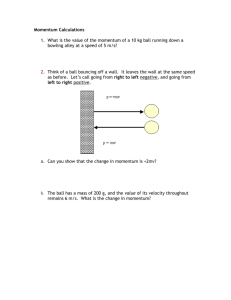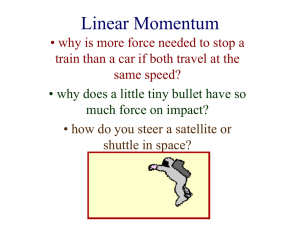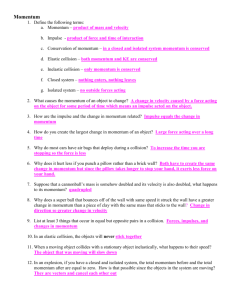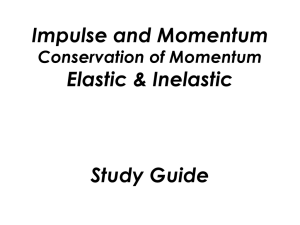pop3tb08
advertisement
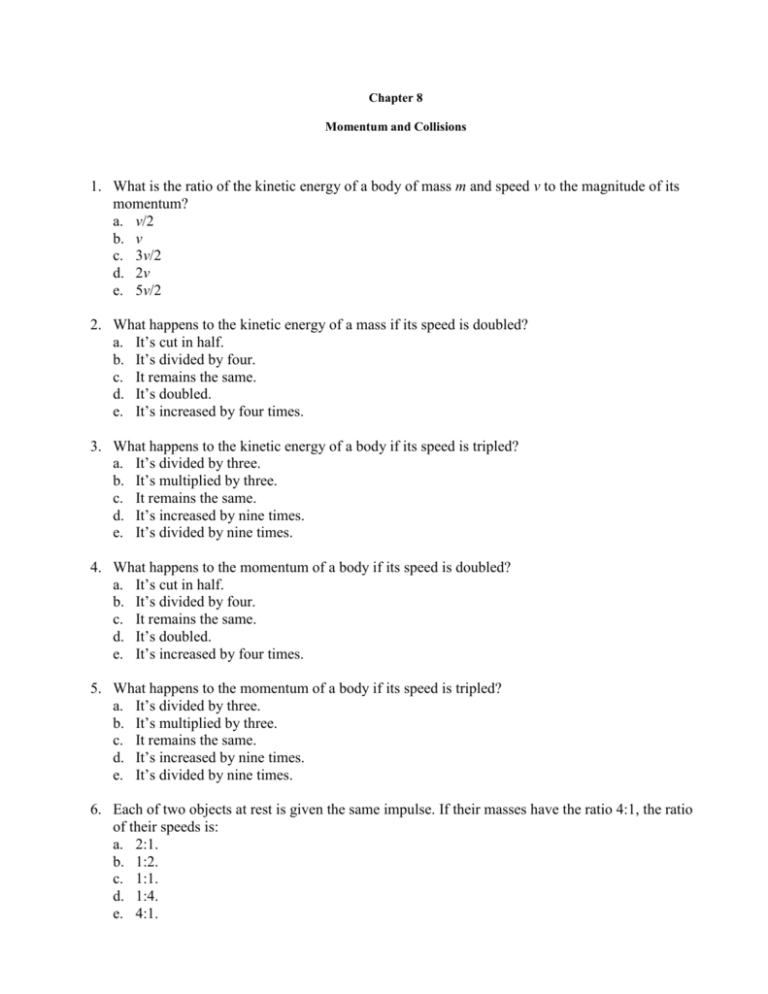
Chapter 8 Momentum and Collisions 1. What is the ratio of the kinetic energy of a body of mass m and speed v to the magnitude of its momentum? a. v/2 b. v c. 3v/2 d. 2v e. 5v/2 2. What happens to the kinetic energy of a mass if its speed is doubled? a. It’s cut in half. b. It’s divided by four. c. It remains the same. d. It’s doubled. e. It’s increased by four times. 3. What happens to the kinetic energy of a body if its speed is tripled? a. It’s divided by three. b. It’s multiplied by three. c. It remains the same. d. It’s increased by nine times. e. It’s divided by nine times. 4. What happens to the momentum of a body if its speed is doubled? a. It’s cut in half. b. It’s divided by four. c. It remains the same. d. It’s doubled. e. It’s increased by four times. 5. What happens to the momentum of a body if its speed is tripled? a. It’s divided by three. b. It’s multiplied by three. c. It remains the same. d. It’s increased by nine times. e. It’s divided by nine times. 6. Each of two objects at rest is given the same impulse. If their masses have the ratio 4:1, the ratio of their speeds is: a. 2:1. b. 1:2. c. 1:1. d. 1:4. e. 4:1. 7. A sphere of radius 2 m which has its diameter collinear with the z axis is located above the xy plane and is tangent to the xy plane at the origin (0, 0, 0). The coordinates of its center of mass, in m, are: a. 0, 0, 2. b. 2, 0, 0. c. 0, 2, 0. d. 2, 2, 0. e. 2, 2, 2. 8. A cube of side length 4 m has three sides collinear with the x, y and z axes respectively. The coordinates of its center of mass, in m, are: a. 0, 0, 2. b. 2, 0, 0 . c. 0, 2, 0. d. 2, 2, 0. e. 2, 2, 2. 9. A cylinder of radius 1 m and length 4 m has its base in the xy plane and its axis collinear with the z axis. The coordinates of its center of mass, in m, are: a. 0, 0, 2. b. 2, 0, 0 . c. 0, 2, 0. d. 2, 2, 0. e. 2, 2, 2. 10. A rectangular plate with 4 m and 2 m sides collinear with the x and y axes respectively is shown below. The coordinates of the center of mass, in m, are: a. 1, 2 y b. 2, 1 4m c. 3, 4 d. 4, 3 2m e. 2, 4 x 105 11. A circular plate of radius 3.0 m is located with its center on a line at 45° to the x axis. The circle is tangent to both the x and y axis as shown. What are the coordinates in m of its center of mass? y a. 2, 1 b. 1, 2 c. 2, 4 d. 3, 3 e. 3, 6 x 12. A 1500 kg car has the same momentum as a 2500 kg truck moving at 15 m/s. How fast is the car moving in m/s? a. 15 b. 25 c. 35 d. 45 e. 50 13. An object of mass 2.3 kg is moving with a velocity of ( 2.0i + 3.0j ) m/s. What are its x and y components of momentum in kg m/s? a. ( 2.0, 3.0 ) b. ( 3.0, 2.0 ) c. ( 2.3, 3.2 ) d. ( 3.2, 2.3 ) e. ( 4.6, 6.9 ) 14. A 1200 kg car is moving with a speed of ( 11i + 6.2j ) m/s. What is the magnitude of its momentum in kg m/s? a. 1.3 x 104 b. 4.3 x 104 c. 7.4 x 104 d. 1.5 x 104 e. 2.4 x 104 15. A 0.012 kg ball is thrown straight up with a speed of 11 m/s. What is the magnitude of its momentum in kg m/s when it reaches half its maximum height? a. 0.084 b. 0.093 c. 0.098 d. 0.073 e. 0.049 106 16. A 4.1 kg rifle is suspended by strings and fires a 0.0030 kg bullet at a speed of 1500 m/s. What is its recoil speed in m/s? a. 0.99 b. 0.83 c. 1.1 d. 1.4 e. 0.87 17. A 3.0 kg block moving at 5.0 m/s catches up with a 5.0 kg block moving in the same direction at 3.0 m/s. They stick together. With what speed in m/s do they move? a. 2.5 b. 3.8 c. 2.9 d. 4.1 e. 3.5 18. Two 150 g blocks, traveling on a frictionless surface, approach the opposite ends of a spring of force constant 1500 N/m. The blocks, traveling in opposite directions along the same straight line, have speeds of magnitude 1.1 m/s relative to the surface. What is the maximum compression of the spring in m when the blocks strike the spring? a. 0.012 b. 0.013 c. 0.014 d. 0.015 e. 0.016 19. A 5.00 kg body is acted on by a horizontal force as shown in the graph. What impulse in kg m s is transmitted to the body by the force? a. 15.5 F (N ) b. 7.50 c. 17.5 5 d. 32.5 e. 27.5 4 3 2 1 0 t (s) 1 2 3 4 107 5 6 7 8 20. A 2.5 kg body, initially at rest, is acted on by the horizontal force shown in the graph. What is its speed in m/s when t 11 s ? F(N) a. 18 b. 25 6 c. 27 5 d. 36 4 e. 45 3 2 1 t(s) 0 1 21. 2 3 4 5 6 7 8 9 10 11 What average horizontal force in N is experienced by a 5 kg object when acted on by the force shown below from t 0 s to t 4 s ? a. 1.0 b. 2.0 F(N) c. 3.0 6 d. 4.0 5 e. 5.0 4 3 2 1 t(s) 0 1 2 3 4 5 6 7 8 9 10 11 22. A car accelerates from 0 m/s to 8.3 m/s in 6.0 s. What was the average force in N on a 50 kg passenger in the car? a. 58 b. 62 c. 64 d. 69 e. 73 23. A car accelerates from 0 m/s to 9.8 m/s in 7.0 s. What linear impulse in Ns has been delivered to a 60 kg passenger in the car? a. 640 b. 590 c. 480 d. 570 e. 520 108 24. The Earth’s mass is 5.98 10 24 kg . If a 5.48 10 3 kg meteor were to strike a stationary Earth at a speed of 150 m/s, the Earth’s recoil speed would be: a. 1.37 x 10-19. b. 1.48 x 10-19. c. 1.93 x 10-19. d. 2.08 x 10-19. e. 2.31 x 10-19. 25. A 0.0111 kg bullet hits a 5.25 kg block. The two move off together at a speed of 7.35 m/s. What was the speed of the bullet in m/s before the collision? a. 1.97 x 103 b. 9.23 x 102 c. 2.89 x 103 d. 3.48 x 103 e. 3.88 x 103 26. A 1250 kg car moving with a speed of 28.1 m/s collides head on with a 9260 kg truck moving with a speed of 22.3 m/s in the opposite direction. If they stick together, with what speed in m/s will they be moving after the collision? a. 16.3 b. 22.0 c. 24.1 d. 24.7 e. 25.3 27. A 1250 kg car moving with a speed of 28.1 m/s runs into the back end of a 9260 kg truck moving with a speed of 22.3 m/s. They are both coasting and moving in the same direction. They stick together. With what speed in m/s do they move after the collision? a. 8.25 b. 23.0 c. 24.5 d. 25.2 e. 25.7 28. A 1250 kg car moving with a speed of 28.1 m/s collides head on with a railroad car of mass 2.50 x 104 kg moving with a speed of 3.0 m/s. The car becomes attached to the railroad car in the collision. If the collision takes 0.592 s, what was the average force on the car in N? a. 6.25 x 104 b. 7.62 x 104 c. 9.97 x 103 d. 4.61 x 103 e. 1.95 x 104 109 29. A 1250 kg car moving with a speed of 28.1 m/s collides head on with a railroad car of mass 2.50 x 104 kg moving with a speed of 3.00 m/s If the collision takes 0.592 s, what was the average acceleration of the railroad car in m/s2? a. 1.25 b. 1.85 c. 2.5 d. 2.75 e. 2.81 30. Two balls of equal mass, A and B, have velocities of 6i m/s and -4i m/s, respectively. If they collide elastically, what are their velocities in m/s after the collision? Ball A’s velocity is listed first. a. 6i, -4i b. -4i, 6i c. 6i, -4j d. -4j, 6j e. 6j, -4j 31. A 660 N woman is sitting on a frictionless surface. She throws a 1.3 kg book at a speed of 15 m/s. What is her recoil speed in m/s? a. 0.29 b. 0.0027 c. 0.0028 d. 0.031 e. 0.33 32. A 5.1 kg block moving at 2.1i m/s collides inelastically with a 2.4 kg block moving at 1.5i m/s. They stick together. What is their velocity after collision in m/s? a. 0.98i b. 1.5i c. 1.9i d. 2.1i e. 2.3i 110 33. Object A, whose center is at (2.0m, 2.0m) has a mass of 40 kg. Object B has its center at (10m, 4.0m) and has a mass of 30 kg. What is the x component of their center of mass in m? a. 2.9 y(m) b. 5.4 c. 6.1 d. 6.3 B e. 6.7 4 A 2 x(m) 0 2 34. 4 6 8 10 Object A, whose center is at (2.0m, 2.0m) has a mass of 40 kg. Object B has its center at (10m, 4.0m) and has a mass of 30 kg. What is the y component of their center of mass in m? a. 2.9 y(m) b. 5.4 c. 6.1 d. 6.3 B e. 6.7 4 2 A x(m) 0 2 35. 4 6 8 10 A 2.5 kg body moves along the x axis with a velocity of 3.8 m/s. A 1.7 kg body moves along the x axis with a velocity of -1.3 m/s. Find the velocity in m/s of the center of mass of the system. a. 1.3 b. 1.5 c. 1.7 d. 1.9 e. 2.1 111 36. A 2.5 kg body moves along the x axis with a velocity of 3.8 m/s. A 1.7 kg body moves along the x axis with a velocity of -1.3 m/s. Find the momentum in kg m/s of the center of mass of the system. a. 6.5 b. 6.7 c. 6.9 d. 7.1 e. 7.3 37. 87 kg of fuel are burned by a rocket per second. If the exhaust gases have a speed of 2.8 x 103 m/s, what is the thrust in N on the rocket? a. 2.1 x 105 b. 2.2 x 105 c. 2.3 x 105 d. 2.4 x 105 e. 2.5 x 105 38. A rocket burns 93 kg of fuel per second. The exhaust gasses have a speed of 1.2 x 103 m/s. What is the thrust in N on the rocket? a. 1.1 x 105 b. 2.2 x 105 c. 3.3 x 105 d. 4.4 x 105 e. 5.5 x 105 39. A rocket burns 93 kg of fuel per second. The exhaust gasses have a speed of 1.2 x 103 m/s. What is the acceleration in m/s2 on the rocket? The rocket’s mass at this instant is 810 kg. a. 75 b. 90 c. 115 d. 130 e. 140 40. An 8.0 kg object moving 4.0 m/s in the positive x direction has a one-dimensional collision with a 2.0 kg object moving at 3.0 m/s in the opposite direction. The final velocity of the 8.0 kg object is 2.0 m/s in the positive x direction. What is the total kinetic energy in J of the two-mass system after the collision? a. 32 b. 52 c. 41 d. 25 e. 29 112 41. A 1.6 kg ball is attached to the end of a 0.40 m string to form a pendulum. This pendulum is released from rest with the string horizontal. At the lowest point of its swing, when it is moving horizontally, the ball collides with a 0.80 kg block initially at rest on a horizontal frictionless surface. The speed of the block just after the collision is 3.0 m/s. What is the speed of the ball in m/s just after the collision? a. 1.7 b. 1.1 c. 1.5 d. 1.3 e. 2.1 42. A 4.0 kg particle is moving horizontally with a speed of 5.0 m/s when it strikes a vertical wall. The particle rebounds with a speed of 3.0 m/s. What is the magnitude of the impulse in N · s delivered to the particle? a. 24 b. 32 c. 40 d. 30 e. 8.0 43. A 2.0 kg object moving with a velocity of 5.0 m/s in the positive x direction strikes and sticks to a 3.0 kg object moving with a speed of 2.0 m/s in the same direction. How much kinetic energy in J is lost in this collision? a. 2.4 b. 9.6 c. 5.4 d. 0.6 e. 6.0 44. A 12 g bullet is fired into a 3.0 kg ballistic pendulum initially at rest and becomes embedded in it. The pendulum subsequently rises a vertical distance of 12 cm. What was the initial speed of the bullet in km/s? a. 0.38 b. 0.44 c. 0.50 d. 0.54 e. 0.024 45. A 2000 kg truck traveling at a speed of 6.0 m/s makes a 90° turn in a time of 4.0 s and emerges from this turn with a speed of 4.0 m/s. What is the magnitude of the average resultant force in kN on the truck during this turn? a. 4.0 b. 5.0 c. 3.6 d. 6.4 e. 0.67 113 46. A 1.2 kg object moving with a speed of 8.0 m/s collides perpendicularly with a wall and emerges with a speed of 6.0 m/s in the opposite direction. If the object is in contact with the wall for 2.0 ms, what is the magnitude of the average force in kN on the object by the wall? a. 9.8 b. 8.4 c. 7.7 d. 9.1 e. 1.2 47. A 1.5 kg playground ball is moving with a velocity of 3.0 m/s directed 30° below the horizontal just before it strikes a horizontal surface. The ball leaves this surface 0.50 s later with a velocity of 2.0 m/s directed 60° above the horizontal. What is the magnitude of the average resultant force in N on the ball? a. 14 b. 11 c. 18 d. 22 e. 3.0 48. The only force acting on a 2.0 kg object moving along the x axis is shown. If the velocity vx is -2.0 m/s at t = 0, what is the velocity in m/s at t = 4.0 s? a. -2.0 b. -4.0 Fx (N) c. -3.0 d. +1.0 e. +5.0 +4 0 -4 -8 114 1 2 3 4 t (s) 49. The only force acting on a 2.0 kg object moving along the x axis is shown. If the velocity vx is +2.0 m/s at t = 0, what is the velocity in m/s at t = 4.0 s? a. +4.0 b. +5.0 F (N) c. +6.0 +16 d. +7.0 e. +2.0 x +8 t(s) 0 1 2 3 4 -8 50. The speed of a 2.0 kg object changes from 30 m/s to 40 m/s during a 5.0 s time interval. During this same time interval, the velocity of the object changes its direction by 90°. What is the magnitude of the average total force in N acting on the object during this time interval? a. 30 b. 20 c. 40 d. 50 e. 6.0 51. The only force acting on a 2.0 kg mass moving along the x axis is given by Fx = 4t N, where t is in seconds. If the velocity of the mass vx is 3.0 m/s at t = 0, at what value of t will vx be equal to 8.0 m/s? a. 1.4 b. 2.0 c. 2.2 d. 1.7 e. 2.5 52. A 3.0 kg ball with an initial velocity of (4i + 3j) m/s collides with a wall and rebounds with a velocity of (-4i + 3j) m/s. What is the impulse in N · s exerted on the ball by the wall? a. +24 i b. -24i c. +18j d. -18j e. +8i 53. A 2.0 kg ball with an initial velocity of (3i - 4j) m/s collides with the floor and rebounds with a velocity of (3i + 4j) m/s. What is the impulse in N · s exerted on the ball by the floor? a. +16j b. -16j c. +12i d. -12i e. +8j 115 54. A 2.4 kg ball falling vertically hits the floor with a speed of 2.5 m/s and rebounds with a speed of 1.5 m/s. What is the magnitude in Ns of the impulse exerted on the floor by the ball? a. 9.6 b. 2.4 c. 6.4 d. 1.6 e. 1.0 55. In an elastic collision: a. only energy is conserved. b. only momentum is conserved. c. only force is conserved. d. both momentum and energy are conserved. e. both force and momentum are conserved. 56. In an inelastic collision: a. only energy in conserved. b. only momentum is conserved. c. only force is conserved. d. both momentum and energy are conserved. e. both force and momentum are conserved. 57. The momentum of a system can change a. if it is isolated. b. if two balanced forces act on the system. c. if an elastic collision occurs within the system. d. if an unbalanced force acts on the system. e. if an inelastic collision occurs within the system. 58. Two bodies, A and B, each moving at constant velocity on a frictionless horizontal surface, have equal kinetic energies. mB 3mA . The relation between their momenta is: 1 a. p B pA . 3 1 p . b. p B 3 A c. p B pA . d. p B 3 pA . e. p B 3pA . 116 59. Two bodies, A and B, have equal momentum. mB 3mA . The relation between their kinetic energies is: 1 a. K B K A . 9 1 b. K B K A . 3 c. K B KA . d. K B 3K A . e. K B 9K A . 60. Two pendulums, A and B, of equal length and equal mass, each initially side by side at rest have a perfectly elastic collision. When A is raised and released, it strikes B with velocity of magnitude v A . The magnitudes of the velocities after the collision are v A and vB. Which equation or inequality is correct? a. v A vB. b. vB vA. c. v A vA . d. vB v A e. vB vA . 61. A system consists of a car with momentum 25,000 kg m , South, and a truck with momentum s kg m , North. They have a head on collision and stick together. Which statement s correctly describes the system immediately after the collision? a. The total kinetic energy of the system is converted to thermal energy. b. The total mechanical energy of the system is converted to thermal energy. c. The total kinetic energy of the system is conserved. d. The total mechanical energy of the system is conserved. e. Part of the kinetic energy of the system is converted to thermal energy. 100,000 62. Two bodies, A and B, arrive at the base of a frictionless inclined plane with equal momenta of magnitude p. mB 3mA . The ratio of the maximum distance, dB , that B travels up the plane to the maximum distance, dA , that A travels up the plane is: 1 a. dB dA . 9 1 b. dB dA . 3 c. dB dA . d. dB 3dA . e. dB 9dA . 117 63. Two bodies, A and B, arrive at the base of a frictionless inclined plane with equal momenta of magnitude p. mB 2mA . The ratio of the time tB for B to reach the maximum height to the time tA for A to reach the maximum height is: 1 a. tB tA . 4 1 b. tB tA . 2 c. tB tA . d. tB 2tA . e. tB 4tA . 64. Spaceman Steve celebrates his fastening of the last space station bolt by shooting foam from a fire extinguisher. The force back on the 10 kg fire extinguisher – ignore changes in its mass – is 200 N. Steve, who is not tethered to the space station, has a mass of 70 kg. What is his kg m momentum in 10 s later when the fire extinguisher runs out of foam? s a. 0 b. 250 c. 1750 d. 2000 e. His momentum does not change, since he is holding on to the fire extinguisher. 65. Equal forces act for equal times on two experimental hockey pucks, A and B, which start from rest. mB 2mA . The relation between their momenta when the forces cease acting is: 1 a. p B pA . 2 1 p . b. p B 2 A c. p B pA . d. p B 2 p A . e. p B 2pA . 66. A system consists of two spheres, A and B, of equal radius but unequal mass, with mB 2mA . They are connected to the ends of a spring sitting on a frictionless horizontal surface. Initially the spring is stretched to a length 1.25 times its length at equilibrium. The two spheres are released simultaneously. When the spring’s length has returned to its equilibrium length e , the position of the center of mass of the system relative to its position with the spring stretched has: a. moved 0.25 e to the left. b. moved 0.125 e to the left c. moved 1/6 e to the left. d. moved 1/3 e to the left. e. has not moved from its original position. 118 67. A 1000 kg barge loaded with 9000 kg of machine parts, as shown in A below, is traveling kg m downstream with momentum 20,000 . The parts are then shifted as shown in (B) below. s Ignore friction between the barge and the water. What is the momentum of the barge and parts kg m in after the parts are shifted? s a. 2000 b. 2750 c. 12,000 d. 20,000 10 m 5m 5m e. 27,500 (a) (b) 68. A 1000 kg race car travels exactly once around a 2000 m radius circular track at a speed of 80 m/s. The magnitude of the change in momentum of the car in Ns in this time is: a. 0 b. 80 c. 40,000 d. 80,000 e. 503,000 69. Two masses, A and B, with MB 2MA , are released at the same time and allowed to fall straight down. Neglect air resistance. When we compare their momenta after they have fallen equal distances, we find that: a. p B pA . b. p B 2pA . c. p B 4p A . d. p A 2pB . e. p A 4pB . 70. Two masses, A and B, with MB 2MA , are released at the same time and allowed to fall straight down. Neglect air resistance. When we compare their momenta after they have fallen for equal times, we find that: a. p B pA . b. p B 2pA . c. p B 4p A . d. p A 2pB . e. p A 4pB . 119 71. A system initially consists of a ball of mass m at rest at height h above the Earth and the Earth, of mass ME . When the ball has fallen a distance h/2 , the total momentum of the system is: a. 0. b. m 2gh . c. ME 2gh . d. e. ME m ME m 2gh . 2gh . 72. A 1000-kg automobile changes its speed from 10 m/s to 24 m/s. What is its momentum change in kg km/s? a. 45 b. 24 c. 14 d. 55 e. 34 73. A 1000-kg automobile moving with a speed of 24 m/s collides with a 500-kg automobile initially at rest. If the two stick together, what is the momentum in kg km/s of the two cars after the collision in a frame moving 10 m/s in the same direction as the moving cars? a. 55 b. 24 c. 45 d. 14 e. 9 74. A 1000-kg automobile moving with a speed 24 m/s collides with a 500-kg car initially at rest. If the two stick together, what is the velocity in m/s of the two cars after the collision relative to an automobile moving in the same direction at 15 m/s? a. 14 b. 16 c. 24 d. 48 e. 1 120 Chapter 8 Answers Number Type Answer Number Type Answer Number Type Answer 1. C a 31. 2 a 61. C e 2. C e 32. 2 c 62. C a 3. C d 33. 3 b 63. C b 4. C d 34. 3 a 64. 3 c 5. C b 35. 2 c 65. C c 6. C d 36. 2 e 66. C e 7. C a 37. 2 d 67. C d 8. C e 38. 2 a 68. C a 9. C a 39. 2 e 69. 3, C b 10. C b 40. 2 c 70. 3, C b 11. 1 d 41. 2 d 71. C a 12. 1 b 42. 2 b 72. 1 c 13. 1 e 43. 2 c 73. 3 e 14. 2 d 44. 3 a 74. 1 e 15. 2 b 45. 2 c 16. 2 c 46. 2 b 17. 2 b 47. 2 b 18. 2 e 48. 3 c 19. 3 e 49. 3 a 20. 3 a 50. 2 b 21. 2 c 51. 3 c 22. 2 d 52. 3 b 23. 2 b 53. 3 a 24. 3 a 54. 3 a 25. 2 d 55. C d 26. 2 a 56. C b 27. 2 b 57. C d 28. 3 a 58. 3 d 29. 2 c 59. 3 b 30. 2 b 60. 3 d 121

